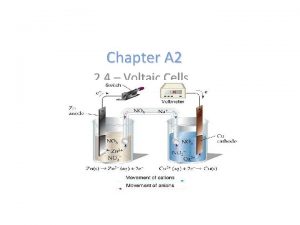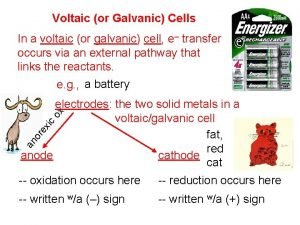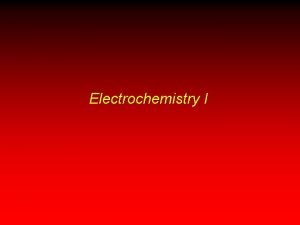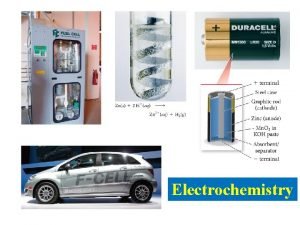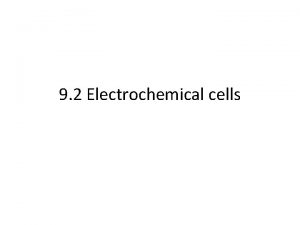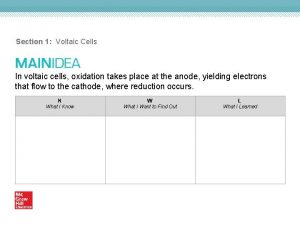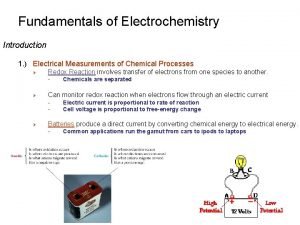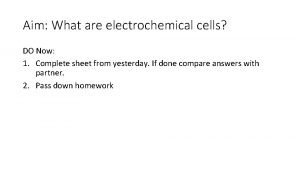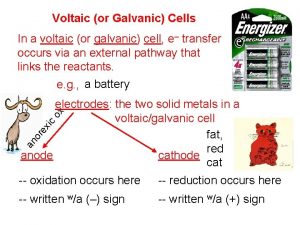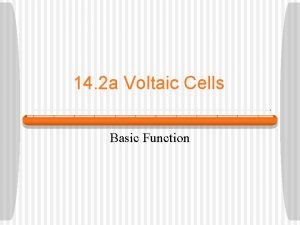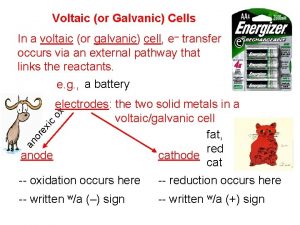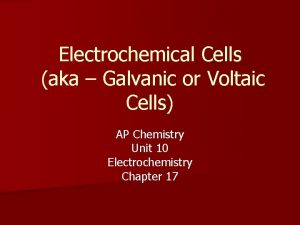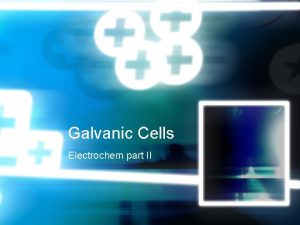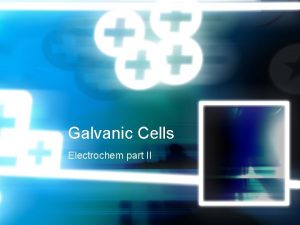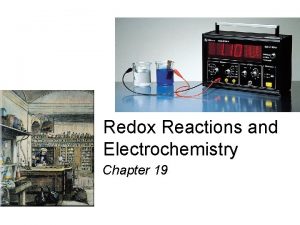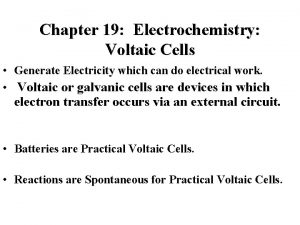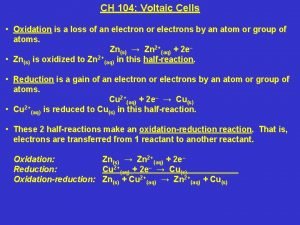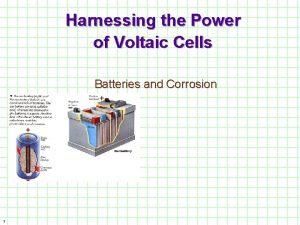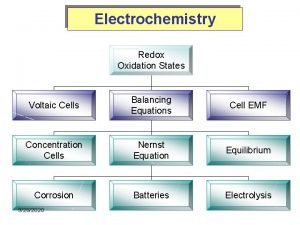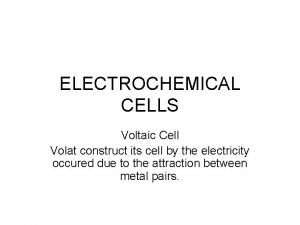Chapter A 2 4 Voltaic Cells Voltaic cells



































- Slides: 35

Chapter A 2. 4 – Voltaic Cells

Voltaic cells The focus of our studies on metals has so far been focused on what’s happening on the surface of the metal (e. g. tarnishing) The rest of this chapter focuses on another area of the reaction – the movement of electrons between metals just like the word “cell” in biology, the term cell in chemistry refers to a distinct structure that interacts with the environment › an example of a cell is a AA battery

Voltaic cells • though commonly we refer to a voltaic cell as a “battery”, technically cells are only referred to as a battery when several are together • when an electronic device is operating, voltaic cells provide a continuous flow (current) of electrons, which is converted into current to power the device

Voltaic cells • the voltaic cell that you know looks like this: • this is simple and compact version of the voltaic cell we will make in the lab.

Voltaic cells • an electrode is a solid piece of metal that is suspended in a solution and connected to an external circuit.

Voltaic cells • the electrode zinc, is immersed into an electrolyte solution, where the zinc electrode acquires an excess of electrons, becoming negatively charged

Voltaic cells • the other electrode is usually composed of a different material (usually copper) and will become positively charged

Voltaic cells once a current is closed between the two electrodes, the electrons will repel from the zinc electrode, pass through the circuit and be used by whatever device is connected, then flow through the positive electrode

Voltaic cells • the reaction will continue until one substance can no longer be sustained.

Voltaic cells while cells can often be built with both electrodes in the same container, the cells that we will study in Science 20 are a little more complex instead of both electrodes being suspended in the same electrolyte solution, each is in its own container each electrode is suspended in a solution containing the same metal’s ions - e. g. Zn is suspended in Zn 2+(aq)

Voltaic cells • a salt bridge is a glass U-shaped tube that is filled with an ionic solution • this is to allow for free flow of electrons from one solution to the other

How the cell works: because it is the more reactive of the two metals, the zinc electrode will become oxidized, giving away electrons these electrons will travel from the electrode, through a metal wire, and then into an electronic device › in the lab, the device we will be using will be a voltmeter, allowing us to measure the amount of electricity passing through

How the cell works: the electrons will pass through the device, back through another wire, into the copper electrode › these electrons will be attracted to the Cu 2+(aq) ions in the solution over time, the zinc electrode will shrink in size (as Zn 2+) and the copper electrode will grow (Cu 2+ Cu) › if the two solutions were not connected, the zinc would run out of electrons and the cell would stop working › the solution in the salt bridge allows a continuous flow of electrons back into the zinc solution

How the cell works:

Analyzing a voltaic cell: Step #1: identify the electrode where oxidation occurs – locate the two metals on the activity series (right side) – the metal closer to the bottom will be oxidized = reducing agent – the electrode that is oxidized is called the anode – the other electrode is reduced, and is called the cathode

Analyzing a voltaic cell: Step #2: describe the oxidation process in the anode write the oxidation half-reaction › the anode will decrease in size over time because the metal is turning into metal ions › electrons leave the anode and travel to the external circuit running the electronic device › in the lab, a voltmeter is used instead of an electronic device – this allows you to measure the amount of electricity being produced because the anode is the electrode where the electrons originate, it is considered the negative electrode

Analyzing a voltaic cell: Step #3: describe the reduction process in the cathode • the electrons will travel through the electronic device and back into the cathode • the electrons will be attracted to the positively-charge metal ions in the cathode solution • the cathode ions will be deposited on the metal electrode

Analyzing a voltaic cell: Step #4: describe how the salt bridge completes the circuit eventually, the anode would run out of electrons and the voltaic cell would stop working the salt bridge connects the cathode back to the anode to allow the replenishment of electrons on the anode side › the salt bridge contains a third solution › the positive ions from the solution will be attracted to the cathode, while the negative ions from the solution will migrate toward the ion

Example: • in this voltaic cell: – zinc is the anode – it is oxidized – copper is the cathode – it is reduced – the solution in the salt bridge is KCl(aq) – chloride ions are a spectator ion – their job is to replenish the electron supply at the anode

Practice Problem: 1. Draw a voltaic cell using the following supplies: › › › two beakers U-tube & cotton balls wire & voltmeter tin and magnesium strips solutions of Sn. SO 4(aq), Mg. SO 4(aq), and Na. NO 3(aq) 2. Label the direction of e- flow, the anode, cathode, OA, RA, - and + electrodes, voltmeter and salt bridge

Practice Problem (Solution):

Cell notation voltaic cells can also be represented using short hand cell notation Zn(s) | Zn 2+(aq) || Cu 2+(aq) | Cu(s) anode salt bridge cathode oxidation reduction the anode is listed on the left, the cathode on the right › the vertical line | represents a boundary between a metal and its solution › the double line || represents the salt bridge

Homework: • VOLTAIC CELLS WORKSHEET

Chapter A 2. 5 – Electrolytic Cells

Electrolytic vs. voltaic an electrolytic cell is a system where a nonspontaneous redox reaction occurs › recall that a reaction that is non-spontaneous will only occur if energy is added › in an electrolytic cell, energy is added in the form of electricity spontaneous? requires energy? produces voltage? use change in energy Voltaic yes no yes energy source exothermic Electrolytic no yes no electroplating endothermic

Electroplating the metals, like gold, that are the most stable and corrosion-resistant are also the most precious (and expensive) › if you want to manufacture a metal object that is resistant to corrosion it would not be costeffective to make the whole thing out of gold › instead, a thin coating of gold could be applied to the surface of a more affordable metal

Electroplating the object to be coated will be submerged in a solution of metal ions (e. g. silver ions) › an external energy source supplies energy to the electrons to force them to flow from the electrode into the solution › this turns the plating metal ions into metal atoms, which will accumulate on the surface of the object to be plated.

Electrolytic cells Step #1: › electrons from the plating metal (e. g. gold) are attracted to the + electrode of the power source › this leaves the Au(s) atoms short on electrons, which causes Au+(aq) ions to be added into the solution

Electrolytic cells • Step #2: – electrons flow through the power source • Step #3: – electrons accumulate on the surface of the object to be plated

Electrolytic cells Step #4: › Au+(aq) ions from the solution are attracted to the electrons on the object to be plated › when they gain these electrons, they turn into solid gold again and form a gold coating

Electroplating • electroplating is a particularly good way to protect metals that are easily oxidized, like iron • metals that work as good electroplaters are chromium, platinum, silver and gold

Gold jewelry solid gold • gold plated – › karats - pure gold is 24 K › gold is a soft metal, so it is often combined with other metals like brass (copper and zinc) and nickel to make it more durable › the number of karats in the gold refers to how many 1/24 th of gold it contains by law, every piece of gold jewelry must be stamped with the karat mark if you have a piece of gold plated jewelry, care must be taken to avoid any deep scratches • deep scratches will expose the oxidizable metal underneath

Other uses for electrolytic cells refining metals › a sample of impure metal (anode), pure metal (cathode) › ions of the pure metal will travel from the anode to the cathode to build up the atoms of pure metal electrolysis › decomposition of a compound by means of an electric current › e. g. electrolysis of water makes it decompose into O 2 and H 2

Other uses for electrolytic cells producing non-metals › non-metals, especially the halogens, are difficult to obtain in pure form because they are so reactive › non-metal atoms will accumulate around the anode of an electrolytic cell recharging voltaic cells › when you use a battery recharger, you are using an electrolytic cell to reverse the process that occurs normally in the voltaic cell › you are literally re-charging the voltaic cell with a new supply of electrons

Homework: • ELECTROLYTIC CELLS WORKSHEET Chapter A 2 Quiz: DATE:
 Voltaic cells example #2 worksheet answers
Voltaic cells example #2 worksheet answers Chapter 21 electrochemistry
Chapter 21 electrochemistry Voltaic and galvanic cells
Voltaic and galvanic cells Chapter 8 cellular reproduction cells from cells
Chapter 8 cellular reproduction cells from cells Balance redox
Balance redox Voltaic cell electron flow
Voltaic cell electron flow Primary battery and secondary battery
Primary battery and secondary battery Voltaic cell virtual lab
Voltaic cell virtual lab Voltaic fundamental
Voltaic fundamental Voltaic fundamentals
Voltaic fundamentals Voltaic fundamentals
Voltaic fundamentals Voltaic aim
Voltaic aim Voltaic aim
Voltaic aim Pns water view position
Pns water view position Tubular secretion
Tubular secretion Parafollicular
Parafollicular Gametic cells vs somatic cells
Gametic cells vs somatic cells Why dna is more stable than rna
Why dna is more stable than rna Chlorocruorin
Chlorocruorin Eukaryotic cells vs prokaryotic
Eukaryotic cells vs prokaryotic Plant vs animal cells venn diagram
Plant vs animal cells venn diagram Prokaryotic cells
Prokaryotic cells Organelle trail
Organelle trail Masses of cells form and steal nutrients from healthy cells
Masses of cells form and steal nutrients from healthy cells Pseudostratified vs simple columnar
Pseudostratified vs simple columnar Are plant cells prokaryotic or eukaryotic
Are plant cells prokaryotic or eukaryotic Which organisms are prokaryotes
Which organisms are prokaryotes Cell substance
Cell substance Chapter 6 how cells harvest chemical energy
Chapter 6 how cells harvest chemical energy 4 primary tissue types
4 primary tissue types Body tissue
Body tissue Chapter 3 cells and tissues
Chapter 3 cells and tissues Cell membrane phospholipids
Cell membrane phospholipids Body tissues chapter 3 cells and tissues
Body tissues chapter 3 cells and tissues Anatomy of a generalized cell figure 3-1 answer key
Anatomy of a generalized cell figure 3-1 answer key Stained cheek cell
Stained cheek cell
